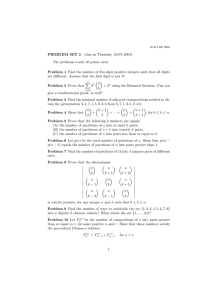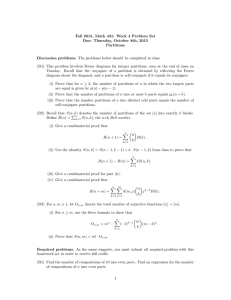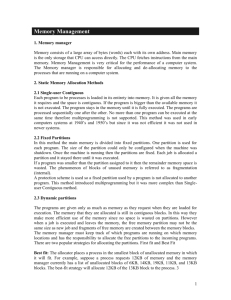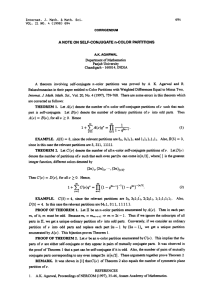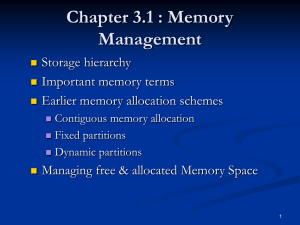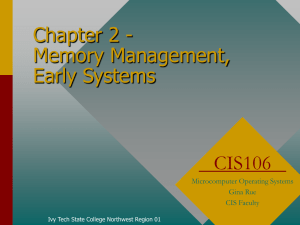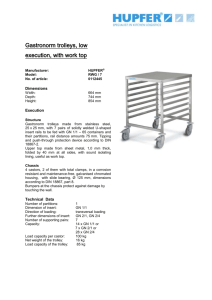MATH 579 Exam 5 Solutions 1. Calculate the number of
advertisement
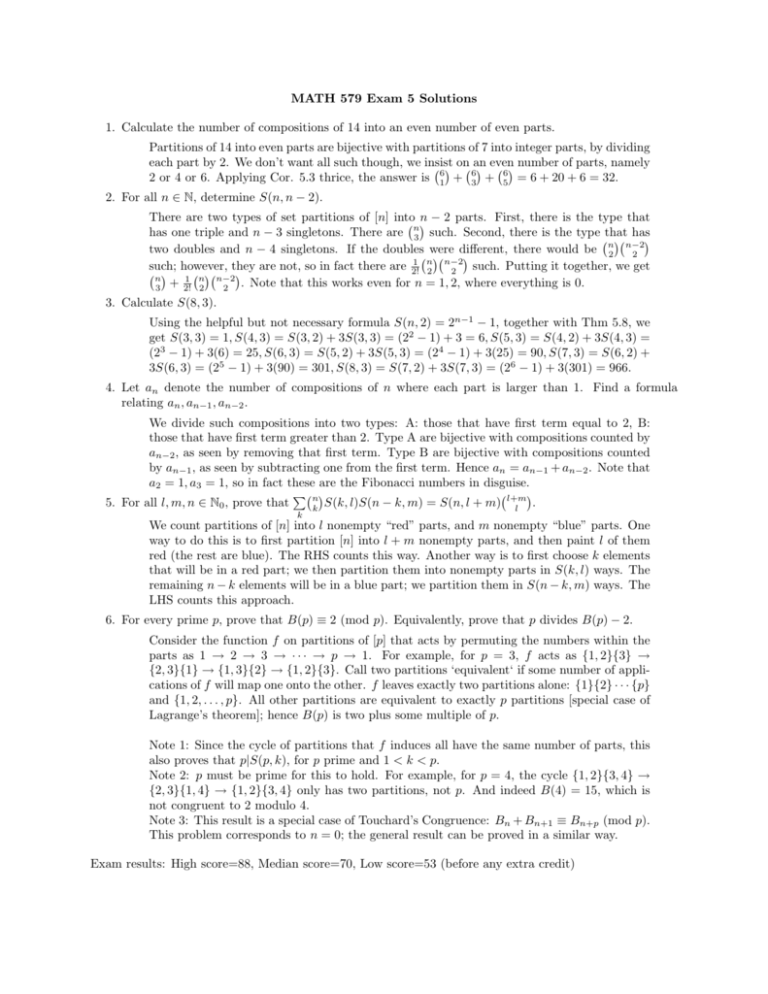
MATH 579 Exam 5 Solutions
1. Calculate the number of compositions of 14 into an even number of even parts.
Partitions of 14 into even parts are bijective with partitions of 7 into integer parts, by dividing
each part by 2. We don’t want all such though, we insist
on an
even number of parts, namely
2 or 4 or 6. Applying Cor. 5.3 thrice, the answer is 61 + 63 + 65 = 6 + 20 + 6 = 32.
2. For all n ∈ N, determine S(n, n − 2).
There are two types of set partitions of [n] into n − 2 parts. First, there is the type that
has one triple and n − 3 singletons. There are n3 such. Second, there is the type that has
two doubles and n − 4 singletons. If the doubles were different, there would be n2 n−2
2
1 n n−2
such. Putting it together, we get
such; however, they are not, so in fact there are 2!
2
2
n
1 n n−2
3 + 2! 2
2 . Note that this works even for n = 1, 2, where everything is 0.
3. Calculate S(8, 3).
Using the helpful but not necessary formula S(n, 2) = 2n−1 − 1, together with Thm 5.8, we
get S(3, 3) = 1, S(4, 3) = S(3, 2) + 3S(3, 3) = (22 − 1) + 3 = 6, S(5, 3) = S(4, 2) + 3S(4, 3) =
(23 − 1) + 3(6) = 25, S(6, 3) = S(5, 2) + 3S(5, 3) = (24 − 1) + 3(25) = 90, S(7, 3) = S(6, 2) +
3S(6, 3) = (25 − 1) + 3(90) = 301, S(8, 3) = S(7, 2) + 3S(7, 3) = (26 − 1) + 3(301) = 966.
4. Let an denote the number of compositions of n where each part is larger than 1. Find a formula
relating an , an−1 , an−2 .
We divide such compositions into two types: A: those that have first term equal to 2, B:
those that have first term greater than 2. Type A are bijective with compositions counted by
an−2 , as seen by removing that first term. Type B are bijective with compositions counted
by an−1 , as seen by subtracting one from the first term. Hence an = an−1 + an−2 . Note that
a2 = 1, a3 = 1, so in fact these are the Fibonacci numbers in disguise.
P n
l+m
5. For all l, m, n ∈ N0 , prove that
.
k S(k, l)S(n − k, m) = S(n, l + m)
l
k
We count partitions of [n] into l nonempty “red” parts, and m nonempty “blue” parts. One
way to do this is to first partition [n] into l + m nonempty parts, and then paint l of them
red (the rest are blue). The RHS counts this way. Another way is to first choose k elements
that will be in a red part; we then partition them into nonempty parts in S(k, l) ways. The
remaining n − k elements will be in a blue part; we partition them in S(n − k, m) ways. The
LHS counts this approach.
6. For every prime p, prove that B(p) ≡ 2 (mod p). Equivalently, prove that p divides B(p) − 2.
Consider the function f on partitions of [p] that acts by permuting the numbers within the
parts as 1 → 2 → 3 → · · · → p → 1. For example, for p = 3, f acts as {1, 2}{3} →
{2, 3}{1} → {1, 3}{2} → {1, 2}{3}. Call two partitions ‘equivalent‘ if some number of applications of f will map one onto the other. f leaves exactly two partitions alone: {1}{2} · · · {p}
and {1, 2, . . . , p}. All other partitions are equivalent to exactly p partitions [special case of
Lagrange’s theorem]; hence B(p) is two plus some multiple of p.
Note 1: Since the cycle of partitions that f induces all have the same number of parts, this
also proves that p|S(p, k), for p prime and 1 < k < p.
Note 2: p must be prime for this to hold. For example, for p = 4, the cycle {1, 2}{3, 4} →
{2, 3}{1, 4} → {1, 2}{3, 4} only has two partitions, not p. And indeed B(4) = 15, which is
not congruent to 2 modulo 4.
Note 3: This result is a special case of Touchard’s Congruence: Bn + Bn+1 ≡ Bn+p (mod p).
This problem corresponds to n = 0; the general result can be proved in a similar way.
Exam results: High score=88, Median score=70, Low score=53 (before any extra credit)


